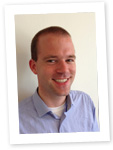Modelling of HIV in the Netherlands - an interview with Rob van den Hengel
Rob van den Hengel is a PhD student at Stichting HIV Monitoring (SHM) and is conducting research into the modelling of HIV infection to gain insight into the course of the infection. We spoke with Rob about his research.
research into the modelling of HIV infection to gain insight into the course of the infection. We spoke with Rob about his research.
Can you tell us something about your background?
I graduated two years ago as a mathematician from the University of Utrecht. During my Masters I focused on mathematical methods in epidemiology and genetics. Then, during my thesis I spent time at the RIVM in the epidemiology department. Immediately after graduating I continued in epidemiology and worked as a junior researcher at the Central Veterinary Institute in Lelystad, modelling the spread of livestock diseases in the Netherlands. After 18 months in this role I thought it would be interesting to go further in research and decided that I wanted to do a PhD. I then went looking for places where I could do a PhD and through contacts at the RIVM I finally ended up at SHM in September 2012. At the moment I work at SHM as a PhD student on doctoral research for the University of Amsterdam (UvA).
What does your PhD research involve?
My PhD research focuses on the development of a simulation model that not only allows a description of the HIV epidemic in the Netherlands but provides more insight into the changes in the age of the HIV-infected population, the contribution of migrant populations to new HIV infections, and the size of the HIV epidemic in different risk groups.
The primary purpose of the research is therefore to make a simulation model. The model should especially be able to simulate the impact various policy and prevention methods have on HIV so that we can predict the consequences of specific measures. In addition we are trying to build in a cost assessment. I’m now working to create the model based on the existing data within the SHM database, so that we can use the model to predict how the epidemic will develop in the future.
Why did you choose this topic?
I wasn’t specifically looking for something in HIV but I wanted to do research in the area of epidemiology. I also wanted to do my PhD in the Netherlands. I specifically chose this assignment because I think it’s a very interesting topic, first of all because it is epidemiology. For mathematicians, epidemiology is the overlap between mathematics and medicine. There is, therefore, quite ‘hard’ mathematics, but it needs to remain applicable in practice. I also like that at SHM I can discuss the project with non-mathematicians. This keeps both feet firmly on the ground, otherwise as a mathematician you are inclined to remain too theoretical.
What can ultimately be achieved with your research?
It should allow SHM to better comprehend how the HIV epidemic in the Netherlands works. The beauty of this research is that it perfectly matches the objectives of SHM, namely gaining insight into the HIV epidemic in the Netherlands. The model can map the relationships between different risk groups and how transmission occurs within a risk group. This can be used to investigate the main drivers of the epidemic in the Netherlands. In addition, the model can be used to predict the effectiveness of different interventions.
When do you hope to be ready with your research?
The study last four years, so in principle I should finish in September 2016. I believe I lie well on schedule to achieve this despite the fact that I have to learn a new programming language to go further with the research. This feels like everything has come to a standstill, but it is better to do it immediately rather than getting stuck at the end of the study. The idea is to have a draft of the first research article ready in September this year. So, in one year the first article is drafted, and after that it will probably go faster. In the beginning you need to read a lot and carry out a lot of programming. Following that you are able to make simple adjustments to the scenarios.
What do you hope to do following your research?
I started a PhD because I wanted to continue in research, so after my PhD I’d like to go further with a postdoc. That doesn’t necessarily have to be within the SHM or the field of HIV, but I would definitely like to continue in epidemiology. I may also find it interesting to do something with agent-based modelling. With this you look not only at the individual (individual-based modelling) or groups (compartmental model) in your model, but also on the impact that individuals have on each other within the group. This is fairly new and it seems interesting to me to do something with this method. In any case, I will be busy in research, but I know people that at the end of the study have a very different opinion, so ask me about that again in three years time.
